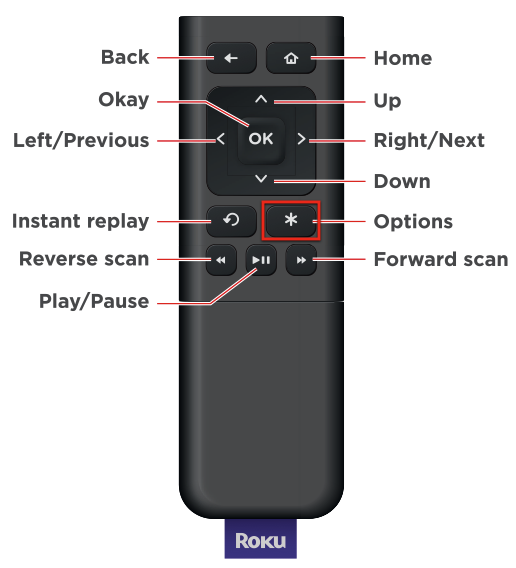

Roku remote buttons explained tv#
Roku, Apple TV, Chromecast, Nvidia Shield TV, OuyaĪmazon Fire TV at a retail store in Canada.Īmazon Fire TV (stylized as amazon fireTV) is a line of digital media players and microconsoles developed by Amazon.
Roku remote buttons explained plus#
But in a TV market that’s filled with countless high-quality screens, it can be the peripherals that end up tipping the scales in one TV maker’s favor, or just make an argument for brand loyalty over the years.Īnd in the case of LG’s Magic Remote, its unique navigation features can feel very hard to go without once you’ve moved on to a different TV brand.Qualcomm Krait 300, quad-core up to 1.7 GHz (1st generation) ĭual-core ARM Cortex-A72 up to 2 GHz and dual-core ARM Cortex-A53 up to 1.573 GHz (2nd generation)ĭolby Digital Plus 7.1 surround sound Naturally, the TV remote is often a last-thought accessory for TV buyers, and clearly nowhere near as important as getting decent picture quality out of your purchase.

The latest (I’m tempted to say ‘final’) form is somehow both the most mundane, visually unremarkable iteration of the Magic Remote to date, while harnessing its best feature – the onscreen cursor – with greater success than ever. It does this while fitting in possibly more shortcut buttons than any other major TV brand, with a six-pack of buttons on the lower end of the remote for Netflix, Amazon Prime Video, Disney Plus, Rakuten TV, Google Assistant and Alexa.īut the most impressive thing about this 2021 model is how its new shape aids the weight distribution, offering more stable navigation in its point-and-click mode. LG AN-MR21GA Magic Remote (Image credit: LG) While some remotes are certainly slimmer – like the sleek, secondary remote that comes with the best Samsung TVs – the new Magic Remote is clearly engineered to fit in the hand more comfortably than most. There’s still a pleasing dip on the remote’s underside for resting a finger, retaining the ergonomic tradition of the Magic Remote while messing with the clicker’s shape as little as possible. (You won’t find them sporting buttons for 3D functionality these days either.)īut it’s the 2021 iteration, the AN-MR21GA, that has fully embraced the norm, doing away with the slight bulge around the remote’s waist to achieve a straight-line shape on both sides, and course-correcting from the previous ‘bottom-heavy’ model. More recent models have cleaved a lot closer more traditional ‘clicking stick’ design of most TV remotes, with 2020’s AN-MR20GA sporting a rectangular shape and even a numerical keypad – a boon for anyone still watching TV channels over broadcast or satellite, if not those that have made the move over to Netflix and other OTT services permanently.

The AN-MR500G model after that was condensed into more of an oval shape, like the floating obelisks from Denis Villeneuve’s 2016 sci-fi drama Arrival, pulling the center of gravity towards the remote’s midpoint but with essentially the same layout – as LG oscillated into a convex shape instead. LG went on to embrace a slightly more space-age design with its 2013 iteration, the AN-MR400, with large (and not especially space-saving) buttons emanating from a central browser wheel, and hard, plastic buttons. In its initial iterations – like the 2011 AN-MR200 – it took after a Matrix coat or vampire cloak in its silhouette, with a tall shape and concave sides. What’s so fascinating about the Magic Remote is how its shape has changed and evolved over the years.


 0 kommentar(er)
0 kommentar(er)
